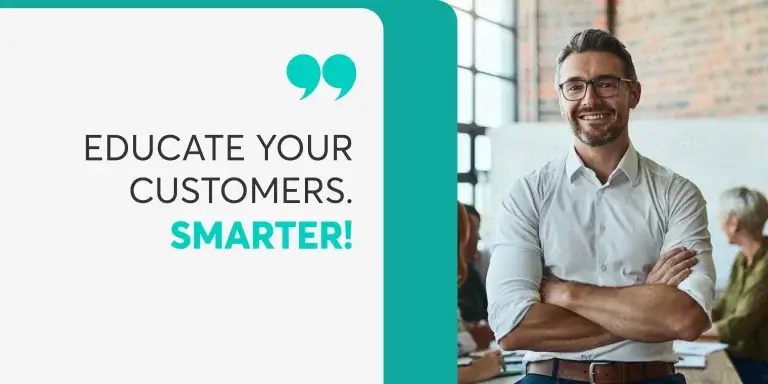Table of Contents
The SaaS industry is accelerating rapidly, especially after the pandemic. At the same time, it needs to keep up with the intense competition and growing customer demands. The introduction of complex products with powerful features to satisfy customer needs has become another challenge, as it’s hard to keep scaling without putting tremendous pressure on customer support.
Therefore, businesses have turned to customer education as a more sustainable way to drive business growth. Through customer education, companies expect to improve critical business KPIs, such as product adoption and the work experience of their customer-facing employees.
It’s worth noting that the rise of customer education is also coincidental with the shift in mindset: businesses become all the more customer-centric and follow a value-first approach. On the other hand, customers have shorter attention spans and little time to devote to learning new software.
Customer education fits the bill just right, satisfying both parties’ needs.
Today we’re sharing with you all the key takeaways from our recent live webinar “How to create a high-impact customer education program” with Chris LoDolce from SaaS Academy Advisors (and Founding Member of the HubSpot Academy) and Panos Siozos LearnWorlds co-founder and CEO.
▶ Watch the webinar to get the full scoop here ◀
Read on to find out everything you need to know about building a customer education program that carries transformative value for your customers and fosters business growth!
Table of contents
Customer Education Definitions
Let’s see some definitions of customer education-related initiatives:
Customer Education
Any purposeful and organized content designed to impart attitudes, knowledge, and skills to customers.
Popular customer education content examples:
Customer Education Program
Strategic initiatives by organizations to educate customers in service of improving top and bottom-line business metrics. The end goal is to improve retention, upselling, cross-selling, product usage, etc.
Corporate Academy
Α holistic alignment of learning teams within an organization in service of a unified customer experience and optimization of resources. This can include industry education, customer education, partner/agency, and employee education. By aligning all of those and repurposing content, you are creating an organization that’s learning and sharing, and you also reduce the number of teams that need to create content.
How do you achieve great education?
As Chris Lo Dolce states: “It’s the excitement; it’s the inspiration, the care, the connection with another human being through learning that makes great education.”
3 Major Mistakes to Avoid When Creating a Customer Education Program
Now, let’s see some common faux-pas that can set your program up for failure and what you need to do instead to gain the most benefit from customer education:
1Imitation
Imitation is when you’re copying an existing customer education program. Instead of trying to be somebody else, try these instead:
2Resources
This mistake happens when you miscalculate the vision of where you want to go vs. the time and budget available. To avoid overpromising and underdelivering:
3Hiring
A great hire on paper doesn’t mean they align with where your customer education program is. Here’s how to go about hiring the members of your learning team:
Customer Education Growth Model
Usually, all customer education programs fall under one of the following stages: Ideation, Beta, Live, Scale, or Innovation.
Ideation
If you’re at the ideation stage, you have recognized the value of customer education and maybe even have a few resources. However, customer education is not a strategic initiative for the business yet. You’re still unclear about how this program is driving business value.
Beta
When you’re at this stage, you must move fast so that your content isn’t outdated by the time it’s released. Maybe you’re offering some live training sessions or webinars to find out what type of content works.
Live
The content is live. You are now measuring not only the learner but also business metrics to measure the impact of customer education.
Scale
You take the content and scale it vertically, horizontally, internally, and globally, repurposing it for customers or employees, translating and localizing it.
Innovation
You have started to reuse the content innovatively, like partnering with universities or nonprofits.
7 Areas of Designing and Growing Your Customer Education Program
Let’s now see the seven areas of designing or growing a high-impact customer education program and what they comprise. When building your learning team, you can use these steps as a roadmap to pick the right person for each job.
Remember rule number one is to design the right program for your company and culture.
1Program Leadership
Above all, a leader needs to have the right mindset. Learning professionals in great customer programs have a sense of responsibility, ownership, and excitement for their job; not for teaching people how to use the product – but for the impact of customer education on the business and the people.
2Program Management
As a part of the program management, you need to do the following:
3Stakeholder Management
The most overlooked area of all. Strategic customer education programs can’t drive value in a vacuum – you need to think about how customer education aligns with the company’s different departments (sales, product, marketing, and customer success) and how it can help them.
As initiatives, priorities, and resources may change, you also need to think about pivoting the program so that it still brings value to the business where it needs it most. For stakeholder management, you need to build:
4Content Design & Development
First, you build your team, and then you go on to design the customer education program. This stage includes:
5Tech Stack Design
This section is all about the tech tools you use when creating the customer education program.
Remember that each time you add another piece of software to your tech stack, it will most probably make things more complicated for your processes. Ask what’s going to happen if you get rid of that tool. Will it make things harder or easier? Could you replace it with a more beneficial tool?
6Marketing Υour Customer Education Program
The following teams can use your content to make their jobs easier:
7Learner Engagement & Support
There is no specific support for customer education. Usually, support is limited to technical support. So there’s no opportunity for learners to engage with the team, only in live training.
Full customer education support includes technical issues and content discussion. Give multi-channel opportunities for communication with learners. It’s essential to find ways (e.g., through a discussion forum in your LMS or emails) to open up the lines of communication and show customers you’re there for them.
When the teams start engaging with their learners, they will create better and better content.
Choosing the Right Platform
This part is critical for ensuring a good User Experience. Look for the following features:
Final Thoughts
We all know that the SaaS world is a competitive one, and as such, many companies are looking for ways to stand out from their competitors. One way in which you can do this? Provide your customers with educational material. What’s more, it seems like an idea whose time has finally come! To help you get started, we’re offering a 30-day free trial.
💡 Need more guidance? Watch our webinar “The blueprint for customer education” here.

Androniki Koumadoraki
Androniki is a Content Writer at LearnWorlds sharing Instructional Design and marketing tips. With solid experience in B2B writing and technical translation, she is passionate about learning and spreading knowledge. She is also an aspiring yogi, a book nerd, and a talented transponster.




